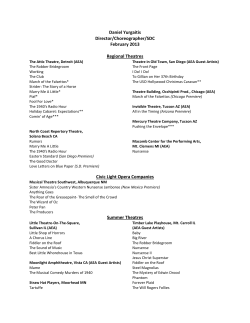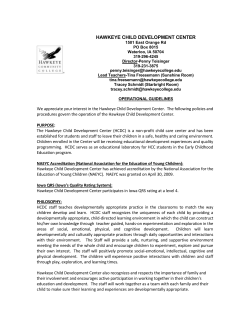
MMS 13 4 IAG Update on AEA Tasks th
1 Assessment and Criticality of Defects and Damage in Materials Systems MMS 13 4th IAG Culham Science Centre 15th January 2004 © AEA Technology 2004 AEA Technology In Confidence Update on AEA Tasks © AEA Technology 2004 AEA Technology In Confidence 2 © AEA Technology 2004 AEA Technology In Confidence 3 4 Assessment and Criticality of Defects and Damage in Materials Systems Task 1 Review Purpose Review & assess current industrial guidelines & codes of practice from a range of industrial sectors Procedure Review existing guidelines for defect assessment (Dow, CEN, BSI, ISO, ASME, NORSOK, ESA, NASA, Boeing, MIL HDBK-17, etc.) Examine defect types applicable to various materials systems Compare defect assessment codes with those for metals Task 1 report issued to IAG for comment and subsequently revised © AEA Technology 2004 AEA Technology In Confidence Review approaches for different industry sectors 5 Assessment and Criticality of Defects & Damage in Materials Systems Defect Types Inclusions Improper splicing/ joining Fibre misalignment and wrinkling Incorrect stacking sequence Porosity Resin starved areas Damage from tooling removal Machining imperfections Manufacturing defects In-service defects Matrix Cracking Heat damage © AEA Technology 2004 AEA Technology In Confidence Debonding Delamination Fibre breakage 6 Assessment and Criticality of Defects & Damage in Materials Systems Task 3 NDE Assessment Visual inspection Ultrasonics (reflection & transmission) Radiography (X-ray and - ray) Laser shearography Thermography Acoustic emission © AEA Technology 2004 AEA Technology In Confidence Tap/ vibration testing 7 EXISTING COMPOSITE RELATED DESIGN STANDARDS & GUIDELINES including manufacturing defect assessment BS 4994 :1987 ASME RTP-1:1995 ASME X: 2001 ISO 14692: 2002 DNV F-100: 2001 DNV OS-C501: 2003 EN 13706: 2001 NORSOK M-622: 1999 ESA Composite Design Handbook Guidelines Commercial aircraft industry guidelines (NASA/ Boeing & Airbus) MIL-HDBK-17: 2002 © AEA Technology 2004 AEA Technology In Confidence Dow Chemicals Specifications 8 MMS 13 Assessment and Criticality of Defects & Damage in Materials Systems DEFECT ASSESSMENT CODES FOR METALLIC STRUCTURES BS 7910: 1999 CODE R6 - NUCLEAR ELECTRIC: 1990 API 579: 2000 Contents – Minimum Requirement Definition of the defect types Definition of material properties needed to perform the assessment Guidance on defect characterisation - geometry Definition of the analysis procedures Guidance on acceptability criteria © AEA Technology 2004 AEA Technology In Confidence Definition of loading to be considered © AEA Technology 2004 AEA Technology In Confidence 9 © AEA Technology 2004 AEA Technology In Confidence 10 11 Inspection techniques Practical assessments on the following inspection techniques have been made during the medium term pressure tests; For thermosetting polymers the time scale for crack initiation is much greater than for crack propagation. This is the fundamental inspection challenge © AEA Technology 2004 AEA Technology In Confidence • Acoustic emission • Ultrasonics • Eddy current • Thermography • Shearography • X-rays © AEA Technology 2004 AEA Technology In Confidence 12 © AEA Technology 2004 AEA Technology In Confidence 13 © AEA Technology 2004 AEA Technology In Confidence 14 15 Ultrasonic Testing The simplest technique uses a hand-held pulse-echo probe - unable to detect 5 mm diameter hole in the steel pipe under the composite overwrap. More sophisticated versions of the ultrasonic technique (angled twin probes, Time of Flight TOFD) were then assessed The Harwell trials were carried out using a multi-channel AEA digital ultrasonic imaging system. The features of this equipment are: • Low inherent noise characteristics • Signal averaging noise suppression capability • Grey scale imaging capability with image enhancement Ultrasonic velocity = [Bulk Modulus (K)/ density ()] Typical velocity ~ 5.9 mm/msec for steel ~ 2.4 - 2.8 mm/msec for composite © AEA Technology 2004 AEA Technology In Confidence • Long range capability 16 Ultrasonic Testing – Principles of simple hand-held probe • • • • • +100% © AEA Technology 2004 AEA Technology In Confidence -100% • © AEA Technology 2004 AEA Technology In Confidence 17 © AEA Technology 2004 AEA Technology In Confidence 18 © AEA Technology 2004 AEA Technology In Confidence 19 © AEA Technology 2004 AEA Technology In Confidence 20 © AEA Technology 2004 AEA Technology In Confidence 21 © AEA Technology 2004 AEA Technology In Confidence 22 © AEA Technology 2004 AEA Technology In Confidence 23 © AEA Technology 2004 AEA Technology In Confidence 24 © AEA Technology 2004 AEA Technology In Confidence 25 © AEA Technology 2004 AEA Technology In Confidence 26 Laser shearography – HST 125 composite cabs © AEA Technology 2004 AEA Technology In Confidence 27 Delamination around opening © AEA Technology 2004 AEA Technology In Confidence 28 © AEA Technology 2004 AEA Technology In Confidence 29 30 LIXI Profiler - summary of results AEA Technology In Confidence Rapid, hand held scanning. Surprisingly effective! High POD in CRIS trial. Information on which wall of pipe defect is in done by moving source. Detected: Severe corrosion in HOIS small bore connector specimen, moderate corrosion not clearly found In UK demo, detected defects under insulation, under composite repair, and internal corrosion in bare straight-pipe Limited information in 1-D profiles, compared with full radiograph © AEA Technology 2004 31 Inspection - Recommendations For composite overwrap repairs there are 3 prevalent defect types, namely the following inspection techniques are recommended; • General wall loss of the substrate (e.g. through internal corrosion) – EM techniques (PEC) or X-rays • Pin hole leaks (e.g. through localised corrosion at a weld) – US although further refinement of the most appropriate form is required Potential for further work continuing on these latter 2 inspection techniques. Also X-ray techniques will be assessed for the detection of pin hole leaks © AEA Technology 2004 AEA Technology In Confidence • Delamination of the composite laminate (e.g. through debonding) – Laser shearography again further refinement is required © AEA Technology 2004 AEA Technology In Confidence 32 © AEA Technology 2004 AEA Technology In Confidence 33 34 © AEA Technology 2004 AEA Technology In Confidence Assessment and Criticality of Defects & Damage in Materials Systems
© Copyright 2025









